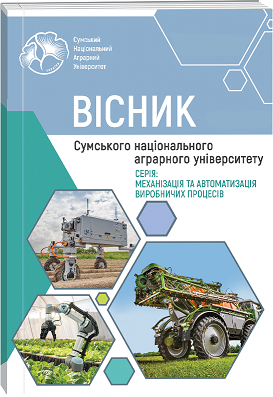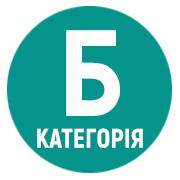ANALYTICAL JUSTIFICATION OF THE CONDUCTIVE DRYING PROCESS OF MEAT
Abstract
Food products with extended shelf life, including dried meat, are in demand among consumers, particularly in regions affected by conflict with russia. Disruptions in electricity supply, caused by the destruction of critical infrastructure due to missile attacks, further contribute to an increased demand for such products on a nationwide scale in Ukraine. Consequently, there is a need to explore environmentally friendly and energy-efficient methods for producing dried meat. One such method is conductive (contact) drying. Drying is a technology based on moisture removal from raw materials, complicating microbial development and chemical reactions that lead to food spoilage. Drying has found widespread applications in food technologies, ranging from traditional methods like convective, conductive, microwave drying, or natural drying, to modern techniques such as sublimation, radiation, vacuum drying etc. A scientific approach to studying conductive drying as a method of preserving food raw materials, including meat, involves reviewing theoretical aspects, which are a significant section in the study of this issue, as well as the physics of boiling in confined spaces of very small size – nanopores. This article is dedicated to exploring the theoretical foundations of conductive meat drying, including the analysis of heat and mass transfer processes, the physics of phase transitions on a nanoscale, the specific mechanism of moisture removal, and the influence of meat raw material characteristics on the process. Within the framework of the research, an analytical approach is used to study the interaction between the heating surface and the raw material. The main problem identified during the research lies in the complicated heat exchange between these two elements of the process. The authors consider factors influencing heat flow, analyzing possible ways to solve the identified problem: the first solution to the problem is determining the temperature of the heating surfaces, the second solution involves mechanically removing the layer of superheated vapor formed near the heating surfaces, and the third solution is compressing the raw material with heating surfaces with a certain effort. This article contributes to understanding the peculiarities of conductive drying and serves as a basis for further practical research aimed at optimization and achieving maximum quality and shelf life of food products, including meat.
References
2. Aksoy, A., Karasu, S., Akcicek, A., & Kayacan, S. (2019). Effects of different drying methods on drying kinetics, microstructure, color, and the rehydration ratio of minced meat. Foods, 8 (6), 216. DOI : 10.3390/foods8060216.
3. Aykan, N. F. (2015). Red meat and colorectal cancer. Oncology reviews, 9(1), 288. DOI : 10.4081/oncol.2015.288.
4. Bolhuis, P. G., & Chandler, D. (2000). Transition path sampling of cavitation between molecular scale solvophobic surfaces. The journal of chemical physics. 113, 8154–8160. DOI :10.1063/1.1315997.
5. Burova, Z., Ivanov, S., Roman, T., Vasyliv, V., Zheplinska, M., Mushtruk, M., Palamarchuk, I., Sarana, V., & Hudzenko, M. (2021). Examination of thermophysical characteristics of food products. Animal science and food technology. 12(3), 18-35. DOI: 10.31548/animal2021.03.002.
6. Cherevko, O. I., & Poperechniy, A. M. (2015). Protsesy i aparaty kharchovykh vyrobnytstv: navch. posib. [Processes and equipment in food production: a textbook]. Harkiv: Svit knig (in Ukrainian).
7. Coudert, F. X., Boutin, A., & Fuchs A. H. (2021). Open questions on water confined in nanoporous materials. Communications chemistry. 4, 106. DOI :10.1038/s42004-021-00544-9.
8. David, R. Eyre, Mercedes, A. Paz, & Paul, M. Gallop. (1984). Cross – linking in collagen and elastin. Annual review of biochemistry. 53. 717 – 748. DOI :10.1146/annurev.bi.53.070184.003441.
9. Dexiao, M., Guozhao, J., Dong, W., & Aimin, Li. (2021). Reinforced contact between sludge and hot wall for enhancing conductive drying by applying external load : heat and mass transfer analysis. Process safety and environmental protection. 154, 372 – 383. DOI : 10.1016/j.psep.2021.08.021.
10. Domingo, J. L., & Nadal, M. (2017). Carcinogenicity of consumption of red meat and processed meat: a review of scientific news since the IARC decision. Food and chemical toxicology. 105, 256–261. DOI : 10.1016/j.fct.2017.04.028.
11. Duan, C., Karnik, R., Lu, M.-C., & Majumdar, A. (2012). Evaporation-induced cavitation in nanofluidic channels. Proc. Natl. Acad. Sci. U. S. A. 109, 3688–3693 DOI :10.1073/pnas.1014075109.
12. Giacomello, A. (2023). What keeps nanopores boiling. The journal of chemical physics. 159 (11), 110902. DOI :10.1063/5.0167530.
13. Hayashi, H. (1989). Drying technologies of foods – their history and future. Drying technology, 7 (2), 315–369. DOI: 10.1080/07373938908916590.
14. Huang, X., Margulis, C. J., & Berne, B. J. (2003). Dewetting-induced collapse of hydrophobic particles. Proc. Natl. Acad. Sci. U. S. A. 100, 11953–11958 DOI :10.1073/pnas.1934837100.
15. Jun, Q., Parag, A., Daris, M. J., Rembo, M. B., & Maarten, A. L. S. (2019). A systematic analysis on tomato powder quality prepared by four conductive drying technologies. Innovative food science. Emerging technologies. 54, 103 – 112. DOI :10.1016/j.ifset.2019.03.013.
16. Kavokine, N., Netz, R. R., & Bocquet, L. (2021). Fluids at the nanoscale: from continuum to subcontinuum transport. Annual review. Fluid Mech. 53, 377–410. DOI :10.1146/annurev-fluid-071320-095958.
17. Khaing Hnin, K., Zhang, M., Mujumdar, A. S., & Zhu, Y. (2018). Emerging food drying technologies with energy-saving characteristics: a review. Drying technology, 37 (12), 1465–1480. DOI: 10.1080/07373937.2018.1510417.
18. Labai, V. Y. (1998). Teplomasoobmin [Heat and mass exchange]. Lviv: Triada-Plius.
19. Le Donne, A., Tinti, A., Amayuelas, E., Kashyap, H. K., Camisasca, G., Remsing, R. C., Roth, R., Grosu, Y. & Meloni, S. (2022). Intrusion and extrusion of liquids in highly confining media: bridging fundamental research to applications. Advanced physics. 7(1), 2052353. DOI :10.1080/23746149.2022.2052353.
20. Llavata, B., García-Pérez, J. V., Simal, S., & Cárcel, J. A. (2020). Innovative pre-treatments to enhance food drying: a current review. Current opinion in food science. 35, 20–26. DOI : 10.1016/j.cofs.2019.12.001.
21. Matthew, D. Shoulders, & Ronald, T. Raines. (2009). Collagen structure and stability. Annual review of biochemistry. 78, 929 – 958. DOI : 10.1146/annurev.biochem.77.032207.120833.
22. Molognoni, L., Daguer, H., Motta, G. E., Merlo, T. C., & Lindner, J. D. (2019). Interactions of preservatives in meat processing: formation of carcinogenic compounds, analytical methods, and inhibitory agents. Food research international. 125, 108608. DOI : 10.1016/j.foodres.2019.108608
23. Miaso ta miasni produkty. Metod vyznachennia vmistu volohy (kontrolnyi metod) [Meat and meat products. Method for determination of moisture content (control method)] (ISO 1442:1997, IDT). DSTU ISO 1442:2005. Кyiv: Derzhspozhyvstandart Ukrainy, 2007, 9 (In Ukrainian).
24. Musielak, G., Mierzwa, D., & Kroehnke, J. (2016). Food drying enhancement by ultrasound: a review. Trends in food science & technology. 56, 126–141. DOI: 10.1016/j.tifs.2016.08.003.
25. Pak, A. O. (2014). Rozrobka naukovykh osnov indukovanoho teplo masoobminu ta yoho vykorystannia v protsesakh ta obladnanni kharchovykh vyrobnytstv [Development of scientific foundations for induced heat and mass transfer and its application in the processes and equipment of food production]. Doctors thesis. Kharkiv (In Ukrainian).
26. Pohozhykh, M. I., Potapov, V. O., Pak, A. O., & Zherebkin, M. V. (2016). Enerhoefektyvni tekhnolohii ta tekhnika sushinnia kharchovoi syrovyny [Energy-efficient technologies and equipment for drying food raw materials]. Kharkiv: KhDUKhT (In Ukrainian).
27. Ramazanov, S., Skrypnyk, V., & Molchanova, N. (2015). Modeliuvannia dynamiky teploprovidnosti v protsesi dvostoronnoho zharennia miasa na osnovi neliniinoi optymizatsii [Modeling of heat conductivity dynamics in the process of twosided frying meat based nonlinear optimization]. Technological audit and production reserves. 3/3(23), 41–47 (In Ukrainian). DOI: 10.15587/2312-8372.2015.44167.
28. Remsing, R. C.,Xi, E.,Vembanur, S., Sharma, S., Debenedetti, P. G., Garde, S., & Patel, A. J. (2015). Pathways to dewetting in hydrophobic confinement. Proc. Natl. Acad. Sci. U. S. A. 112, 8181–8186. DOI :10.1073/pnas.1503302112.
29. Riadh, M. H., Siti Anom, B. A., Marhaban, M. H., & Che Soh, A. (2014). Infrared heating in food drying : an overview. Drying technology. 33(3), 322 – 335. DOI : 10.1080/07373937.2014.951124.
30. Roth, V., & Kroll, K. M. (2006). Capillary evaporation in pores. Journal of. physics : condensed matter. 18, 6517–6530. DOI :10.1088/0953-8984/18/28/007;
31. Salehi, F. (2019). Recent applications and potential of infrared dryer systems for drying various agricultural products: a review. International journal of fruit science, 20 (3), 586–602. DOI: 10.1080/15538362.2019.1616243.
32. Skrypnyk, V. O., Myronov, D. A., & Latysh, V. S. (2021). Rezultaty poperednikh doslidzhen protsesu konduktyvnoho sushinnia zharenoho miasa [Results of previous research on the process of conductive drying of roasted meat]. Novi tekhnolohii i obladnannia kharchovykh vyrobnytstv. Poltava: PUET (In Ukrainian).
33. Skrypnyk, V., & Ponomarenko, B. (2022). The possibility of applying of existing methods for the fried meat drying process. Bulletin of Poltava State Agrarian Academy, (2), 287–295 (In Ukrainian). DOI: 10.31210/visnyk2022.02.34.
34. Skrypnyk, V. O., Molchanova, N. Yu., Fariseiev, A. H., & Tarasenko, D. S. (2024). Pidvyshchennia enerhetychnoi i resursnoi efektyvnosti protsesiv i aparativ konduktyvnoho zharennia miasa.[Improving the energy and resource efficiency of meat conductive roasting processes and apparatus]. Poltava: PDAU (In Ukrainian).
35. Tritt, T. M. (2005). Thermal conductivity: theory, properties, and applications. Springer science & Business media, New York.
36. Truskett, T. M., Debenedetti, P. G., & Torquato, S. (2001). Thermodynamic implications of confinement for a waterlike fluid. The journal of chemical physics. 114, 2401–2418. DOI :10.1063/1.1336569.
37. Zhang, M., Jiang, H., & Lim, R.-X. (2010). Recent developments in microwave-assisted drying of vegetables, fruits, and aquatic products – drying kinetics and quality considerations. Drying technology, 28 (11), 1307–1316. DOI: 10.1080/07373937.2010.524591.
38. Zuhaib, F. Bhat, James, D. Morton, Alaa El-Din, A. Bekhit, Sunil, K. & Hina, F. Bhat. (2021). Thermal processing implications on the digestibility of meat, fish and seafood proteins. Comprehensive reviews in food science and food safety. 20(5), 4511 – 4548. DOI : 10.1111/1541-4337.12802.

 ISSN
ISSN  ISSN
ISSN 



